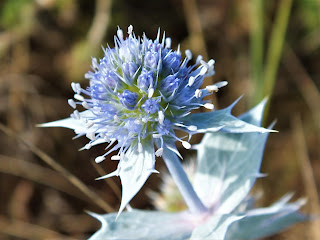The salt marsh is in bloom with swathes of Common Sea Lavender stealing the show, and a host of Common Blue, Meadow Brown, Grayling and Large White butterflies taking advantage of this nectar source.
On the dryer areas patches of the vibrant Sea Holly, most past their best but still some stunning blue flowers to be seen and enjoyed by a wide range of invertebrates.
I was actually recceing the guided walk on Saturday, although the weather forecast is a moving feast at the moment so if you intend coming along please book in advance.
Plenty of signs of Badger activity, the most obvious being the well used latrines which they dig at points around their home range.
 |
| Badger poo in a latrine, this individual has been eating Dewberry fruit |
 |
| Although worn, you can still see the broadness of the print and the claw marks |
Footprints in the mud and sand can be useful but are easily worn away the photo is the best print of a Badger I could get this morning.
Despite the recent heavy showers the ponds on the reserve are in need of a top up, especially the pond on grazing field 2 which is now officially dry....
 |
| Officially dry!! |
A walk along the beach was interesting as you can now see very clearly one of the unique features of the Pembrey dunes, the formation of embryonic dunes, an increasingly rare sight on the West coast of the UK.
The plants growing on the beach are Prickly Saltwort and Sea Rocket these are known as pioneer plants growing in bare sand they along with beach debris start the process of dune formation, the photo clearly shows the build up of sand around the plants and the driftwood; the foundations of a line of embryo dunes, if they survive the winter storms then they will begin to consolidate and become more vegetated thereby deepening the dune system; a guided walk with Llanelli Naturalists on Sunday 12th August may reveal more, see their website for details:-
http://www.llanellinaturalists.org.uk/






No comments:
Post a Comment